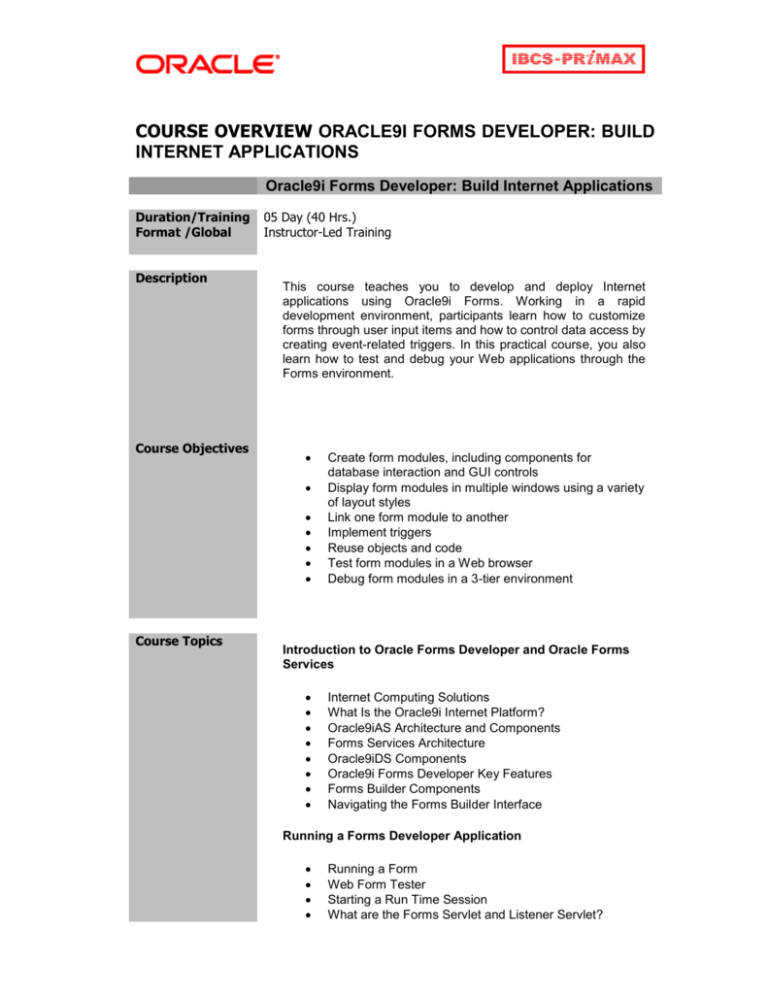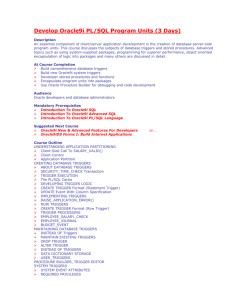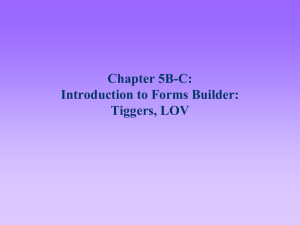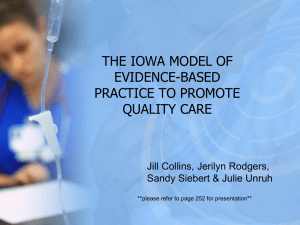Oracle9i Forms Developer: Build Internet Applications
advertisement

COURSE OVERVIEW ORACLE9I FORMS DEVELOPER: BUILD INTERNET APPLICATIONS Oracle9i Forms Developer: Build Internet Applications Duration/Training Format /Global Description Course Objectives 05 Day (40 Hrs.) Instructor-Led Training This course teaches you to develop and deploy Internet applications using Oracle9i Forms. Working in a rapid development environment, participants learn how to customize forms through user input items and how to control data access by creating event-related triggers. In this practical course, you also learn how to test and debug your Web applications through the Forms environment. Course Topics Create form modules, including components for database interaction and GUI controls Display form modules in multiple windows using a variety of layout styles Link one form module to another Implement triggers Reuse objects and code Test form modules in a Web browser Debug form modules in a 3-tier environment Introduction to Oracle Forms Developer and Oracle Forms Services Internet Computing Solutions What Is the Oracle9i Internet Platform? Oracle9iAS Architecture and Components Forms Services Architecture Oracle9iDS Components Oracle9i Forms Developer Key Features Forms Builder Components Navigating the Forms Builder Interface Running a Forms Developer Application Running a Form Web Form Tester Starting a Run Time Session What are the Forms Servlet and Listener Servlet? What Is the Forms Client? Defining Forms Environment Variables What You See at Run Time Identifying the Data Elements Working in the Forms Developer Environment Forms Builder Key Features Forms Developer Executables Forms Builder, Forms Compiler Invoking Forms Executables Forms Builder Module Types Forms Builder Module Object Hierarchy Testing a Form with the Run Form button Starting OC4J Creating a Basic Form Module Creating a New Form Module Creating and modifying a New Data Block Modifying the Layout Template Forms Saving and Compiling a Form Module Deploying a Form Module Moving the Form to the Middle Tier Generating on the Middle Tier Working with Data Blocks and Frames Managing Object Properties Re-entrant Wizards Layout Editor Property Palette Controlling the Behavior of Data Blocks Setting Navigation and Database Properties Controlling the Appearance of Data Blocks Setting Record, Scrollbar and Frame Properties Working with Text Items Creating a Text Item Modifying Appearance Controlling the Data of a Text Item Altering the Navigational Behavior of a Text Item Enhancing the Relationship between Text Item and Database Adding Functionality Displaying Helpful Messages Creating LOVs and Editors LOVs and Record Groups Creating an LOV LOV Properties Creating an Editor Setting Editor Properties Associating an Editor with a Text Item Creating Additional Input Items Creating a Check Box Setting Check Box Properties Creating a List Item Setting List Item Properties Creating a Radio Group Setting Radio Group Properties Creating Noninput Items Creating a Display Item Creating an Image Item Setting Image Item Properties Creating a Push Button Setting Button Properties Creating a Calculated Item Setting Calculated Item Properties Creating a Hierarchical Tree Item Creating Windows and Content Canvases What Are Windows and Canvases? Relationship between Windows and Content Canvases Displaying a Form Module in Multiple Windows Creating a Window Setting Window Properties Displaying a Form Module on Multiple Layouts Creating a New Content Canvas Setting Content Canvas Properties Working with Other Canvas Types Overview of Canvas Types Creating a Stacked Canvas Setting Stacked Canvas Properties Setting Toolbar Properties Creating a Toolbar Canvas Creating a Tab Canvas Setting Tab Canvas Properties Introduction to Triggers Trigger Components Type, Code and Scope Trigger Execution Hierarchy Producing Triggers Creating Triggers Setting Trigger Properties PL/SQL Editor Features Database Trigger Editor Features Writing Trigger Code Adding Functionality with Built-in Subprograms Using Triggers Debugging Triggers The Debugging Process The Debug Console Call Stack Variables Watch List Form Values PL/SQL Packages Global/System Variables Adding Functionality to Items Item Interaction Triggers Defining Functionality for Input Items Interacting with Check Boxes Changing List Items at Run Time Defining Functionality for Noninput Items Displaying LOVs from Buttons Populating Image Items Populating Hierarchical Trees Runtime Messages and Alerts Runtime Messages and Alerts Overview Built-Ins and Handling Errors Controlling System Messages The FORM_TRIGGER_FAILURE Exception Triggers for Intercepting System Messages Creating and Controlling Alerts Handling Errors Raised by the Oracle Database Server Query Triggers Query Processing Overview SELECT Statements Issued During Query Processing WHERE and ORDER BY clauses The ONETIME_WHERE property Writing Query Triggers Query Array Processing Coding Triggers for Enter-Query Mode Overriding Default Query Processing Validation Validation Process Controlling Validation Using Properties Form-level Properties Block-level Properties Item-level Properties Controlling Validation Using Triggers When-Validate-Item Trigger When-Validate-Record Trigger Navigation Navigation Overview Understanding Internal Navigation Controlling Navigation Using Object Properties Writing Navigation Triggers Using Pre- and Post- Triggers Using When-New-<object>-Instance Triggers The Navigation Trap Using Navigation Built-Ins in Triggers Transaction Processing Transaction Processing Overview The Commit Sequence of Events Characteristics of Commit Triggers Common Uses of Commit Triggers The Life of an Update Delete Validation Assigning Sequence Numbers Keeping an Audit Trail Writing Flexible Code Using System Variables for Flexible Coding Using Built-in Subprograms for Flexible Coding Referencing Objects by Internal ID Referencing Items Indirectly Sharing Objects and Code Benefits of Reusable Objects and Code What Are Property Classes? Creating a Property Class Inheriting from a Property Classes What Are Object Groups? Creating and Using Object Groups Copying and Subclassing Objects and Code What is an Object Library






